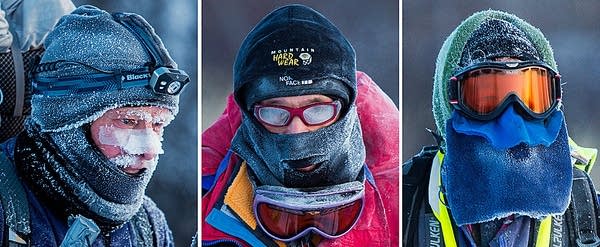Arrowhead 135: The story behind the photos

When I saw the photos from Derek Montgomery today at MPRNews.org I just knew I had to know more. The men and women who enter the Arrowhead 135 Ultra run, bike or ski in a 135-mile race through Minnesota's north woods.
Daunting - period. The athletes take their preparation seriously since their lives can depend on it.
But what about the guy who takes the assignment to photograph the thing? How does HE stay warm? How does he keep his fingers able to function? What about the photo gear?
So, I asked Derek how he approached this shoot.
Create a More Connected Minnesota
MPR News is your trusted resource for the news you need. With your support, MPR News brings accessible, courageous journalism and authentic conversation to everyone - free of paywalls and barriers. Your gift makes a difference.
The clothing?
Derek: Layers were the most important part to staying warm. I had three long-sleeve layers on underneath my winter jacket. For my face, it was a balaclava along with a secondary balaclava that fit tightly over my nose. Then your standard winter hat.
I know mittens would be better in conditions like this, but I opted for some thicker gloves so I could still operate my camera with them on. When you are waiting, you could then just retract your fingers inside the glove and clench your fist around a hot pack to pass the time until the next racer comes by. The one thing I wished I did differently was wear warmer socks or multiple socks because I only had on one pair of socks and my toes were pretty cold by the end of the day. Also, if you feel comfortable doing this, leaving your car running when you take off on the trail is a huge psychological boost knowing that a really warm car is waiting for you as you head out to your next location. (Editor's note: law enforcement tends to frown on this practice.)
How did the photo gear handle the cold?
Derek: The biggest challenge was keeping the camera's viewfinder from fogging up and icing over. You would exhale, the viewfinder would fog up, then you'd have to take your gloves off to wipe it clean and in those few seconds, your fingers can start hurting from the cold. I found myself most comfortable when I was busy shooting, checking out a location or thinking about my next shot -- so basically anytime I was distracted. You can get cold very quickly when you start focusing on the weather. Oh, and lots of hot packs help with fingers when you are walking a lot.
The cameras had a rough day. I had three fully charged batteries for my Canon 1D Mark IV, which is a pretty rugged camera and all those died within an hour of being in the camera. My Canon 5D Mark III was a lot better at handling the cold. Two batteries lasted all day long, but at times the shutter was getting sticky and starting to freeze up so I had to tape hot packs around the battery compartment, which helped a bit. It's challenging because you need to walk so far to reach many of the racers and you need to stand outside for a long time as they get further in the race just for a competitor to come by because they are so spread out so there is only so much you can do outside keeping your batteries fully charged and keeping the spare batteries right against your body.
Derek says preparation makes an assignment like this enjoyable. "It's so quiet on the trail that you can hear each bend and crack of the trees when the wind comes through... it was a pretty fun experience."
As many photographers tend to to, Derek gives the last nod to the people he watched through his viewfinder. "It was challenging for sure," he says, "but think about what I went through compared to these competitors who are out there even longer. The fastest runners take about 40 hours to finish."
Oh, and a glance at the course rules gives testament to what Derek says are constant reminders that blend the serious and the humorous, that the conditions for the athletes can be lethal.